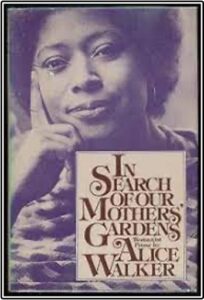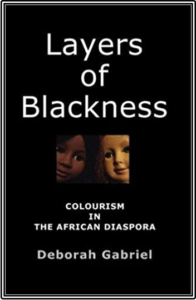 The term ‘colourism’ was coined by Alice Walker in 1982. Walker used the term to refer to forms of light-skin privilege experienced in Black communities in the United States (Norwood and Foreman, 2014). Whilst many scholars have provided alternative definitions of colourism over time, it is important to recognise that colourism operates along two interconnected pathways: (1) inter-racial and intra-racial judgments; and (2) perceptions of skin tones (Strmic-Pawl et al. 2011).
The term ‘colourism’ was coined by Alice Walker in 1982. Walker used the term to refer to forms of light-skin privilege experienced in Black communities in the United States (Norwood and Foreman, 2014). Whilst many scholars have provided alternative definitions of colourism over time, it is important to recognise that colourism operates along two interconnected pathways: (1) inter-racial and intra-racial judgments; and (2) perceptions of skin tones (Strmic-Pawl et al. 2011).
 According to Deborah Gabriel, colourism is a system of privilege and discrimination based on skin tone. That is, the degree of lightness in the pigmentation of one’s skin can warrant certain privileges. For Gabriel, colourism is an internalised form of racism that “involves prejudice, stereotyping and perceptions of beauty amongst members of the same racialized group, whereby light skin is typically more highly valued than dark skin” (Gabriel 2007:11). Thus, colourism is understood as an intra-racial form of prejudice. Similarly, Cedric Herring defines colourism as “the discriminatory treatment of individuals falling within the same social group on the bases of skin color” (2004:3). Therefore, colourism can be experienced as a form of prejudicial treatment within racialised groups whereby darker skinned people suffer this treatment from one another, as well as their lighter-skinned counterparts.
According to Deborah Gabriel, colourism is a system of privilege and discrimination based on skin tone. That is, the degree of lightness in the pigmentation of one’s skin can warrant certain privileges. For Gabriel, colourism is an internalised form of racism that “involves prejudice, stereotyping and perceptions of beauty amongst members of the same racialized group, whereby light skin is typically more highly valued than dark skin” (Gabriel 2007:11). Thus, colourism is understood as an intra-racial form of prejudice. Similarly, Cedric Herring defines colourism as “the discriminatory treatment of individuals falling within the same social group on the bases of skin color” (2004:3). Therefore, colourism can be experienced as a form of prejudicial treatment within racialised groups whereby darker skinned people suffer this treatment from one another, as well as their lighter-skinned counterparts.
Scholars such as Evelyn Nakano Glenn also define colourism as ‘the preference for lighter skin and social hierarchy based on skin tone” (2009:166), whereas others deploy the term ‘color-class hierarchies’ to define colourism as a ‘framework’ that has social, economic, and political implications (Russell-Cole et al. 2013: 37). In this way, colourism is entrenched in societies whereby those with lighter skin are placed at the top, while those with darker skin are relegated towards the bottom, of the social hierarchy as a result of inter-racial stratification. Skin-lightening has become a global phenomenon in which those attempting to lighten their skin seek to acquire higher social, economic, and political capital (see Shroff et al. 2018).
Gabriel (2007) also asserts that colourism does not exist, nor did it evolve independently of, wider systems of White supremacy and racism. As such, inter-racial and intra-racial judgements are informed by perceptions of skin tone rooted in White supremacy and racism.
Colourism also operates on the negative association constructed between ‘darkness’ and ‘Blackness’ that has existed for several centuries (Gabriel 2007). For example, in Europe, “to be black was to be dirty, ugly, evil, deadly, devilish [and to] be white was to be clean, beautiful, good lively and godly…” (Adams, 1996: 139). These ideas around Blackness and Whiteness have attributed ‘superiority’ to White Skin and ‘inferiority’ to Black skin. Such perceptions of dark and light skin have had detrimental ramifications throughout history, cross-culturally and at the present time.
Experiences of colourism are not homogeneous, rather, they are contingent on multiple intersections of race, class, gender, and country. Conceptualising such experiences as differential colourism allows us to account for the multifaceted nature of colourism, whereby different racialised groups across different cultures have been subjected to intra- and inter-racial colourist abuse. For example, Indian actress Tannishta Chatterjee has spoken about the bullying she endured due to her darker complexion (Noman 2020). Colourism is widespread in South Asian countries, where darker skinned South Asian people are heavily discriminated against and seldom seen in media representation, and skin lightening is promoted as lighter skin is regarded as valuable (Noman 2020). Skin-lightening as a product of colourism exists across multiple cultures including countries in Africa, North and South America, Europe, and Asia (Shroff et al. 2018). Thus, establishing colourism into sociological theory and understanding the nuances in colourist experiences are the vital steps needed to dismantle existing oppressive regimes embedded in society and enrich our knowledge of multiple forms of racialised discrimination that are constantly evolving.
 Whilst ‘colourism’ has been used to explain the prejudicial treatment of dark-skinned people, ‘pigmentocracy’ has also been adopted to describe societies in which wealth and social status are determined by skin colour, whereby lighter-skinned people have the highest social status. For example, in Latin America, the socio-economic hierarchy is characterised by a social spectrum of taller, lighter-skinned, elites of European descent at one end, and shorter, darker, native Americans and people of African descent at the other: with studies showing that the darker the person’s skin tone, the poorer the quality of life they are likely to endure (Telles 2014). Pigmentocracies therefore operate on the belief that lighter/White skin is superior, and colourism recognises this form of racial stratification as inherently discriminatory.
Whilst ‘colourism’ has been used to explain the prejudicial treatment of dark-skinned people, ‘pigmentocracy’ has also been adopted to describe societies in which wealth and social status are determined by skin colour, whereby lighter-skinned people have the highest social status. For example, in Latin America, the socio-economic hierarchy is characterised by a social spectrum of taller, lighter-skinned, elites of European descent at one end, and shorter, darker, native Americans and people of African descent at the other: with studies showing that the darker the person’s skin tone, the poorer the quality of life they are likely to endure (Telles 2014). Pigmentocracies therefore operate on the belief that lighter/White skin is superior, and colourism recognises this form of racial stratification as inherently discriminatory.
Essential Readings:
Gabriel, D. (2007) Layers of blackness. London: Imani Media Ltd.
Shroff, H., Diedrichs, P. and Craddock, N. (2018) ‘Skin Color, Cultural Capital, and Beauty Products: An Investigation of the Use of Skin Fairness Products in Mumbai, India’, Frontiers in Public Health, 5.
Strmic-pawl, H. V., Gonlin, V. and Garner, S. (2021) ‘Color in Context: Three Angles on Contemporary Colorism’. Sociology of Race and Ethnicity, 7(3), pp. 289–303.
Further Readings:
Adams, M. V., 1996. The multicultural imagination: Race, color, and the unconscious. Psychology Press.
Glenn, E. N., 2009. “Consuming Lightness: Segmented Markets and Global Capital in the Skin-Whitening Trade.” In Glenn, E. N. (ed) Shades of Difference: Why Skin Color Matters. Stanford, CA: Stanford University Press, pp. 166-187.
Herring, C., 2004. “Skin Deep: Race and Complexion in the ‘Color-blind’ Era.” In herring, C., Keith, V., Horton. H. D. (eds.) Skin deep: How Race and Complexion Matter in the “Color-blind” Era, Chicago, IL: University of Illinois Press, pp. 1-21.
Norwood, J.K., Foreman, V., 2014. “The Ubiquitousness of Colorism: Then and Now.” In Norwood, K. J. (ed) Color Matters: Skin Tone Bias and the Myth of a Post-racial America, New York: Routledge, pp. 9-28.
Russell-Cole, K., Wilson, M., Hall, R. E., 2013. The Color Complex: The Politics of Skin Color in a New Millennium. New York: Anchor Books
Telles, E., 2014. Pigmentocracies: Ethnicity, race, and color in Latin America. UNC Press Books.
Further Resources:
Noman, N. (2020) ‘Skin lightening in South Asia is why we have an anti-Blackness problem’, NBC News.
Bey, J.P. (2022) ‘What is pigmentocracy & genetic annihilation?’, Amexem – video.
BBC News (2022) Colourism, BBC News.
Okoro, C. (2016) ‘Confessions of a D Girl: Colorism and Global Standards of Beauty’, TedX Talks – video.
Questions:
How does Deborah Gabriel define colourism?
In what ways is colourism a useful concept in understanding racialised discrimination?
As societies operate as pigmentocracies, what are the systematic consequences of colourism in such societies?
How can the intersections of race, class, and gender shape one’s experience of colourist abuse?
Are there examples of colourism that can be seen in pop culture?
Submitted by Morise Ogunyimika
7 thoughts on “Zapatismo”